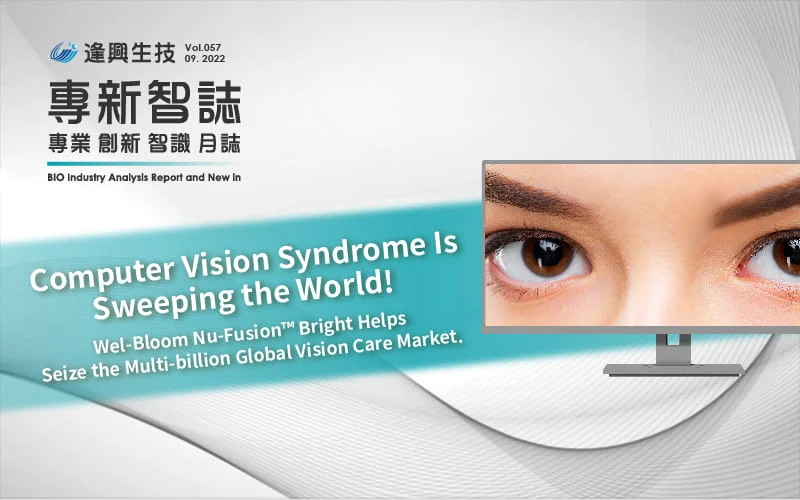
Computer Vision Syndrome Is Sweeping the World! Wel-Bloom Nu-Fusion®Bright Assists in Capturing the Multi-Billion Dollar Global Vision Care Market

Get Addicted to Consumer Electronics Every Day? Phubbers Are at High Risk for Computer Vision Syndrome.
The excessive use of eyes that comes with the development of technology
With the popularity of digital devices, many people spend the bulk of their day as screen time. They send and receive messages on their way to work, use the computer all day in the office, and play games on their devices at leisure. It seems like the modern age revolves around screens. Little wonder why vision-related problems are commonplace, with many phubbers experiencing computer vision syndrome. Consequently, the vision care market grows with each passing day.
If you consciously assess your screen time for the day, the result may shock you! According to GWI, a U.S. market research firm, people will spend an average of over 3 hours per day staring at smartphones, TVs, or other devices, excluding daily working hours[1]. Before the pandemic, the average screen time per person worldwide was about 7 hours a day[2]. A study pointed out that the pandemic lockdown and work-from-home have led to increased digital device usage, raising the average to up to 12 hours[3].
This new overall trend, coupled with home confinement, a catalyst for increasing screen time, has brought an unprecedented challenge to children’s eye health as many vision-related problems are now reported among children.
The Canadian Pediatric Society recommends that for children older than five, daily screen time should be less than 2 hours. However, during the pandemic lockdown, about 89% of Canadian children exceeded this recommended hour. Similarly, compared to the screen time before the pandemic, German children spend an hour more on average, and Tunisian children aged 5–12 spend 111% more on total use. In addition, a study in Chile also found that toddlers and preschoolers have doubled their usage time to more than 3 hours per day[4].
“Computer Vision Syndrome,” a Common Disease of Civilization for Phubbers
Computer vision syndrome (CVS), also known as digital eye strain, describes a group of vision-related problems that result from prolonged computer or digital device use. Some of the symptoms include dry eyes, fatigue, double or blurred vision, shoulder and neck pain, and headaches[5]. Nearly 90% of office workers and other people who spend long hours looking at a screen will be affected by CVS. The U.S. Family Health Centers also indicated that excessive exposure to digital screens increases the risk of developing CVS[6]. However, with the rapid development of technology, people’s habit of using digital devices for work, communication, and entertainment is irreversible. Therefore, the global demand for eye care is bound to grow.

[1] How Much Do We Spend on Screen Time
https://contentwritingjobs.com/blog/screen-time-statistics
[2] Screen Time Statistics: Average Screen Time in US vs. the rest of the world
https://www.comparitech.com/tv-streaming/screen-time-statistics/
[3] Social Connectedness, Excessive Screen Time During COVID-19 and Mental Health: A Review of Current Evidence
https://www.frontiersin.org/articles/10.3389/fhumd.2021.684137/full
[4] Children’s health fears due to rise in screen time
https://www.eurekalert.org/news-releases/946136
[5] How to Avoid Computer Vision Syndrome (CVS)
https://www.goodeyes.com/eye-health/avoid-computer-vision-syndrome-cvs/
[6] Computer Vision Syndrome: How Screen Time Impacts Children’s Vision
https://www.lifqhc.com/computer-vision-syndrome/
Dry Eye and Macular Degeneration are Right Outside Your Door! Common Eye Diseases Affect Phubbers
Water Shortage of Eyes-Dry Eye Disease
The human cornea is covered with a tear film made of three layers: outer lipid, middle aqueous, and inner mucin layer, with the function of lubricating and moisturizing. Whenever we blink, the lacrimal glands are stimulated to secrete tears to maintain the integrity of the tear film. However, staring at the screen for a long time will result in a significant reduction in the number of blinks and a decrease in tear secretion, which will cause the tear film to lose its protective effect and lead to sore and dry eyes. Once our tear film becomes unstable, symptoms of dry eye can occur[7].
Long-term eye fatigue can cause damage to various tissues of the eye, and dry eye syndrome is one of the major ones. In recent years, due to excessive screen time among kids and adolescents, the age distribution of patients tends to be younger, indicating that dry eye is no longer a disease exclusive to the elderly[8]. A report from Future Marketing Insight further indicated that the global dry eye treatment market is expected to exceed $8.84 billion by the end of 2031[9].
The Vision’s Silent Killer-Macular Degeneration
Blue light is another threat caused by long-term exposure to digital devices. In addition to computer and smartphone screens, blue light exists everywhere, from indoor fluorescent and LED lighting to outdoor daylight. Blue light passes through the cornea and lens and reaches the retina. Long-term exposure to high-intensity blue light can lead to eye fatigue, soreness, and tearing. It may also decrease macular pigment density, increase the risk of macular degeneration, and result in blurred vision, visual distortions, difficulty reading words, and other vision-related problems[10]. In serious cases, retinal cells may also be damaged. Macular degeneration is usually not detected at an early stage and often causes great harm when the symptoms appear.
The damage caused by prolonged use of the eyes should not be underestimated. Keeping your peepers healthy should start with developing a daily eye care routine. Recognizing the pressing demand of the market, Wel-Bloom developed an innovative submicronization technology to make nutrients evenly dispersed in a liquid, overcoming the limitations of dosage forms and oral bioavailability. The patented Nu-Fusion® Bright formula and a wide range of options in dosage forms make it easy to cultivate intake habits and open up new horizons for vision care products.

[7] Dry Eye and Screen Use
https://www.webmd.com/eye-health/dry-eye-screen-use
[8] Dry Eye: A Young Person’s Disease?
https://www.reviewofoptometry.com/article/dry-eye-a-young-persons-disease
[9] Dry Eye Syndrome Treatment Market Overview (2022-2031)
https://www.futuremarketinsights.com/reports/dry-eye-syndrome-treatment-market
[10] Blue Light and Your Eyes
https://preventblindness.org/blue-light-and-your-eyes/



